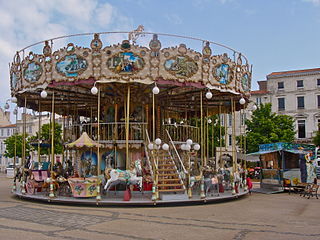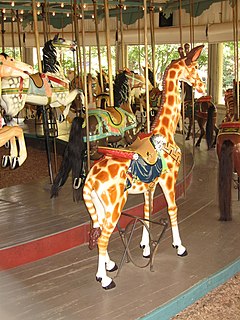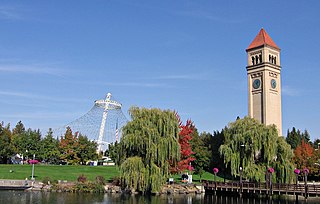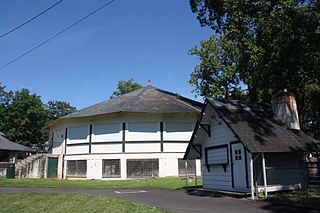
Meridian is the seventh largest city in the U.S. state of Mississippi, with a population of 41,148 at the 2010 census and an estimated population in 2018 of 36,347. It is the county seat of Lauderdale County and the principal city of the Meridian, Mississippi Micropolitan Statistical Area. Along major highways, the city is 93 mi (150 km) east of Jackson, Mississippi; 154 mi (248 km) southwest of Birmingham, Alabama; 202 mi (325 km) northeast of New Orleans, Louisiana; and 231 mi (372 km) southeast of Memphis, Tennessee.

A carousel, roundabout, or merry-go-round, is a type of amusement ride consisting of a rotating circular platform with seats for riders. The "seats" are traditionally in the form of rows of wooden horses or other animals mounted on posts, many of which are moved up and down by gears to simulate galloping, to the accompaniment of looped circus music. This leads to one of the alternative American names, the galloper. Other popular names are jumper, horseabout, horse tornado and flying horses.

The Panama–Pacific International Exposition was a world's fair held in San Francisco, California, United States, from February 20 to December 4, 1915. Its stated purpose was to celebrate the completion of the Panama Canal, but it was widely seen in the city as an opportunity to showcase its recovery from the 1906 earthquake. The fair was constructed on a 636 acre(1 sq. mi., 2.6 km2) site along the northern shore, between the Presidio and Fort Mason, now known as the Marina District.

James Charles Rodgers was an American singer-songwriter and musician who rose to popularity in the late 1920s. Widely regarded as "the Father of Country Music", he is best known for his distinctive rhythmic yodeling. Unusual for a music star of his era, Rodgers rose to prominence based upon his recordings, among country music's earliest, rather than concert performances – which followed to similar public acclaim.

Expo '74, officially known as the International Exposition on the Environment, Spokane 1974, was a world's fair held May 4, 1974, to November 3, 1974 in Spokane, Washington in the northwest United States. It was the first environmentally themed world's fair and attended by roughly 5.6 million people. The heart of the fair park grounds was located on Canada Island, Havermale Island, and the adjacent south bank of the Spokane River, comprising present-day Riverfront Park, in the center of the city.

Glen Echo Park is an arts and cultural center located in Glen Echo, Maryland that, in its former incarnation, was a popular Washington, D.C.-area amusement park that operated for several decades from the early 1900s to the 1960s. The arts and cultural center takes its name from the amusement park.

Pullen Park is a 66.4-acre (0.27 km2) public park immediately west of downtown Raleigh, North Carolina. It is located on Ashe Avenue and is adjacent to the Main and Centennial campuses of North Carolina State University, covering an area between Western Boulevard and historic Hillsborough Street. Founded in 1887, Pullen Park is the oldest public park in North Carolina.

Midway State Park, located in Maple Springs, New York, was established in 1898 by the Jamestown & Lake Erie Railway as a picnic ground. Today, it is recognized as the fifteenth-oldest continually operating amusement park in the United States, and the fifth-oldest remaining trolley park of the thirteen still operating in the United States.

Logansport is a city in and the county seat of Cass County, Indiana, United States. The population was 18,396 at the 2010 census. Logansport is located in northern Indiana at the junction of the Wabash and Eel rivers, northwest of Kokomo.

The Highland Park Dentzel Carousel and Shelter Building is a carousel and building in Highland Park in Meridian, Mississippi. Manufactured about 1896 for the 1904 St. Louis Exposition by the Dentzel Carousel Company of Philadelphia, Pennsylvania, the carousel was sold and shipped to Meridian. Highland Park Dentzel Carousel has been in operation since 1909 and was declared a National Historic Landmark in 1987. It is the only remaining two-row stationary Dentzel menagerie in the world.

The Pullen Park Carousel is a classic wood carousel at Pullen Park in Raleigh, North Carolina. Built in 1900, the carousel contains 52 hand-carved basswood animals, 2 chariots, 18 large gilded mirrors and canvas panels and a Wurlitzer #125 band organ made in 1924 by the Rudolph Wurlitzer Company of North Tonawanda, New York.

Spencer Park Dentzel Carousel, also known as Riverside Park Dentzel Carousel or Logansport Carousel, is a carousel in Riverside Park of Logansport, Indiana.

Broad Ripple Park Carousel is an antique carousel in The Children's Museum of Indianapolis. It was installed in 1917 at an amusement park near the White River in Indianapolis, Indiana, where it remained until the building housing it collapsed in 1956. The ride's mechanism was destroyed, but the animals were relatively unscathed and put into storage by the park's owners, the Indianapolis Department of Parks and Recreation. The animals were carved by the Dentzel Carousel Company some time before 1900 but were assembled by the William F. Mangels carousel company, which also supplied the engine powering the ride.

The Threefoot Building is a historic office building located in downtown Meridian, Mississippi named after the Threefoot family who owned an operated a business in downtown Meridian during the late 19th century and early 20th century. Designed by Claude H. Lindsley and completed in 1929 in the Art Deco style, the 16-story building is still the tallest in the city. It was added to the National Register of Historic Places on December 18, 1979, under the Meridian Multiple Property Submission of buildings contributing to the historic nature of the city's downtown. In 2008 the Threefoot was recognized by the state as a Mississippi Landmark.

Crescent Park Looff Carousel, also known as Crescent Park Carousel or more officially as Crescent Park Looff Carousel and Shelter Building, is a National Historic Landmark in East Providence, Rhode Island.

Riverfront Park, branded as Riverfront Spokane, is a public urban park in Downtown Spokane, Washington that is owned and operated by the Spokane Parks & Recreation Department. The 100-acre (40 ha) park is situated along the Spokane River and encompasses the Upper Spokane Falls, which are the second largest urban waterfall in the United States, and, when combined with the Lower Spokane Falls that sit just outside of the park's boundary, create the largest urban waterfall in the country.

Balboa Park is a 1,200-acre (4.9 km2) historic urban cultural park in San Diego, California, United States. In addition to open space areas, natural vegetation zones, green belts, gardens, and walking paths, it contains museums, several theaters, and the world-famous San Diego Zoo. There are also many recreational facilities and several gift shops and restaurants within the boundaries of the park. Placed in reserve in 1835, the park's site is one of the oldest in the United States dedicated to public recreational use. Balboa Park is managed and maintained by the Parks and Recreation Department of the City of San Diego.

Weona Park Carousel, also known as Dentzel Stationary Menagerie Carousel, is a historic carousel located at Pen Argyl, Northampton County, Pennsylvania. The carousel and its pavilion were built in 1923. The carousel is housed in a wooden, one story, pavilion measuring 20 feet high at center and 80 feet in diameter, with 24 sections each 10 feet 6 inches wide. The carousel has 44 animals and 2 sleighs standing three abreast. They were originally hand carved and painted in the 1890s, c. 1905, and c. 1917. The carousel has a Wurlitzer organ, opus 146. It was constructed by the Dentzel Carousel Company of Philadelphia, Pennsylvania.
Dentzel Carousel may refer to:




























